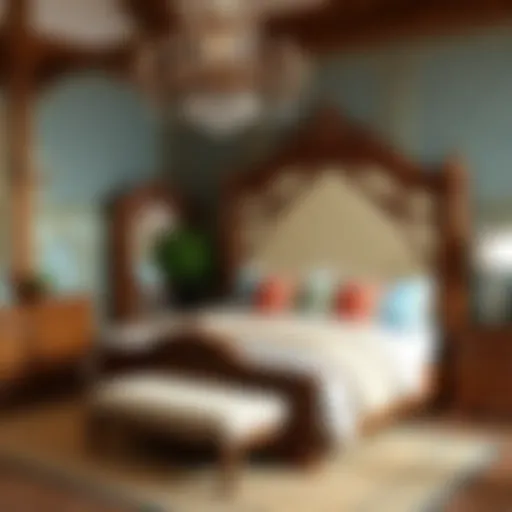Transform Your Bedroom with Large Pictures
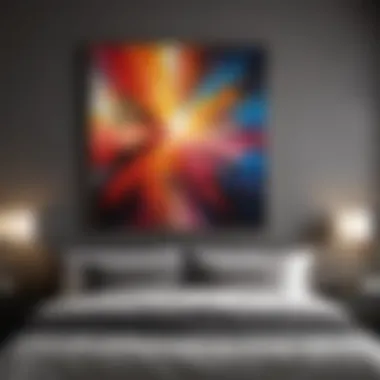
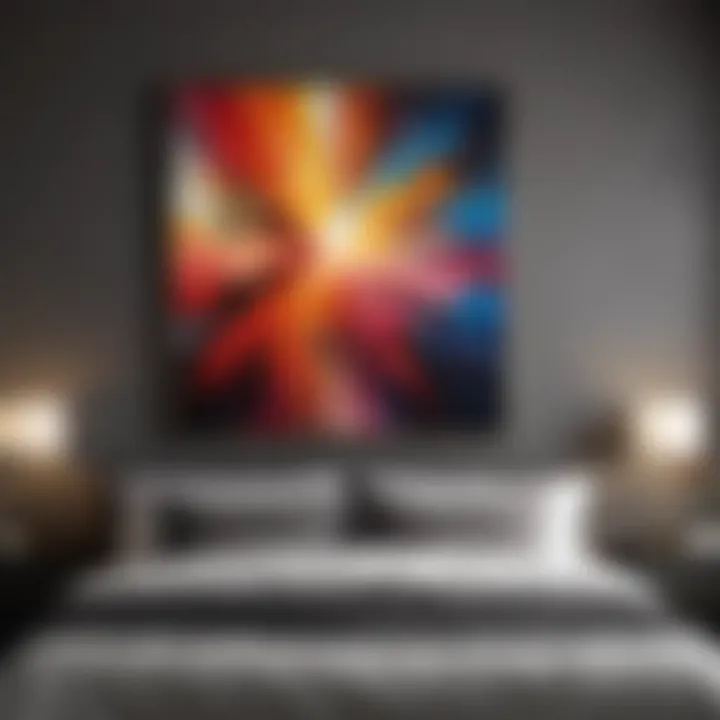
Intro
In modern interior design, large pictures hold significant weight, influencing the overall mood and atmosphere in a bedroom. Incorporating sizeable artworks can elevate the space, making it feel cozier or more dynamic, depending on the chosen style. This guide aims to dissect the process of selecting and using large artworks effectively. By focusing on the functional and decorative aspects, as well as the positive psychological impacts of images, we will navigate the essential techniques for creating a personal sanctuary.
Design Inspirations
Latest Trends in Bedroom Design
Today, there are several inspiring trends in bedroom design. Many homeowners are gravitating towards minimalist styles, where large pictures serve as focal points against simpler backgrounds. This creates a striking contrast, drawing attention to the artwork while maintaining a serene atmosphere. Another popular trend includes technicolor prints, which enliven spaces and infuse personality.
In addition to styles, textures play a vital role. Consider coordinating a large canvas with fabrics like linen or velvet that adorn bedding or curtains. This adds depth and sophistication to the room without overwhelming it.
Color Palettes and Themes
When selecting large pictures, it’s crucial to consider color palettes. Neutral colors, such as whites, grays, and beiges, create a calming environment. Large artworks in these tones can seamlessly blend into the space. However, incorporating vibrant pieces can create an energizing contrast. Here are a few popular themes:
- Nature: Landscapes or floral studies for a tranquil effect.
- Abstract: Bright shapes or forms to energize.
- Black and White Photography: Timeless elegance that fits various interiors.
Choosing colors that resonate with personal emotions can help in establishing the mood desired in the bedroom.
Functional Elements
Space Optimization Tips
Large pictures can alter the perception of space positively. For smaller bedrooms, opt for a single large artwork rather than several smaller pieces. This minimizes clutter and creates a focal point, making the space appear larger than it is. Additionally, consider placing artworks at eye level to enhance visibility and appreciate the details.
Multi-Functional Furniture Choices
Integrating multi-functional furniture can complement large artworks. For instance, a bed frame with built-in shelves can showcase smaller decorative items around a large picture. Nightstands with drawers can hold books, allowing the wall art to take center stage. These choices maximize space and maintain a clean aesthetic.
"Art is not what you see, but what you make others see." - Edgar Degas
Using large pictures within the bedroom decor is not merely about decoration. It involves conscious choices that reflect personal style while heightening comfort and functionality. In the following sections, we will explore best practices for selecting and installing large artworks and delve into their psychological dimensions.
The Role of Art in Bedroom Design
Art plays a crucial role in the overall design and atmosphere of a bedroom. It goes beyond mere decoration; it contributes to how one feels in the space. Large pictures, in particular, have the ability to make a strong visual statement, impacting both aesthetics and ambiance. Choosing the right art enhances the personal style of the room.
Understanding the Psychological Impact of Art
Art elicits emotions. It can inspire, calm, or energize. The psychology behind art is well documented. For example, landscapes can induce tranquility, while vivid abstract works may evoke excitement. When incorporated into a bedroom, the art chosen can significantly affect mood and perception of space. Understanding this impact is essential for selecting the right pieces.
- Studies show that colors and themes influence feelings. For instance, soft blues and greens create a serene environment, making them ideal for a resting space.
- On the other hand, warm colors like reds and oranges can be stimulating, which might be suitable for a more active space within the bedroom, such as a reading nook.
Consider how the chosen images reflect personal experiences. A picture of a beloved vacation place may bring joy each time seen. This personal connection can enhance the emotional well-being of the room's occupants.
Functionality of Large Pictures in Space
Large pictures serve various functions in a bedroom. First, they act as focal points. When placed strategically, they draw the eye and can organize the space visually. For example, a large painting above the bed can anchor the room, allowing other elements to balance around it. This creates harmony.
Moreover, large artwork can help with space perception. In a small room, a picture that suggests depth can make it feel larger. Conversely, in expansive spaces, large pictures can fill empty walls, making the area feel more intimate.
- Key Functions of Large Pictures:
- Focal Point Creation: They direct attention, making the design purposeful.
- Space Enhancement: They can alter perceptions of size.
- Personal Touch: They express taste and style.
In summary, incorporating large pictures is not just about aesthetics. It is a method to enhance the mood of the bedroom while also considering practical design elements. The intersection of art and functionality forms a vital aspect of thoughtful bedroom design.
Choosing the Right Large Picture
Choosing the right large picture is essential in the process of beautifying your bedroom. Large artwork acts not only as a decorative element but also sets the mood within the space. The pictures that you choose can resonate with your personal style and influence the ambiance, thus making selection a crucial aspect. When you pick pieces that align with your interests and preferences, you foster a sense of comfort. Furthermore, having art that speaks to you can enhance your relaxation by promoting a soothing atmosphere. This section will delve into key considerations in this choice.
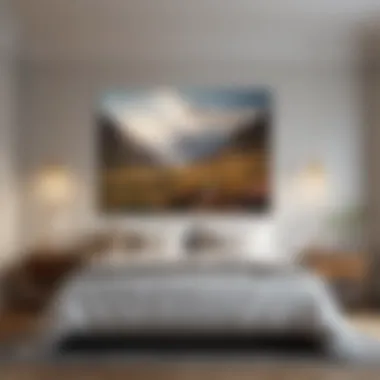
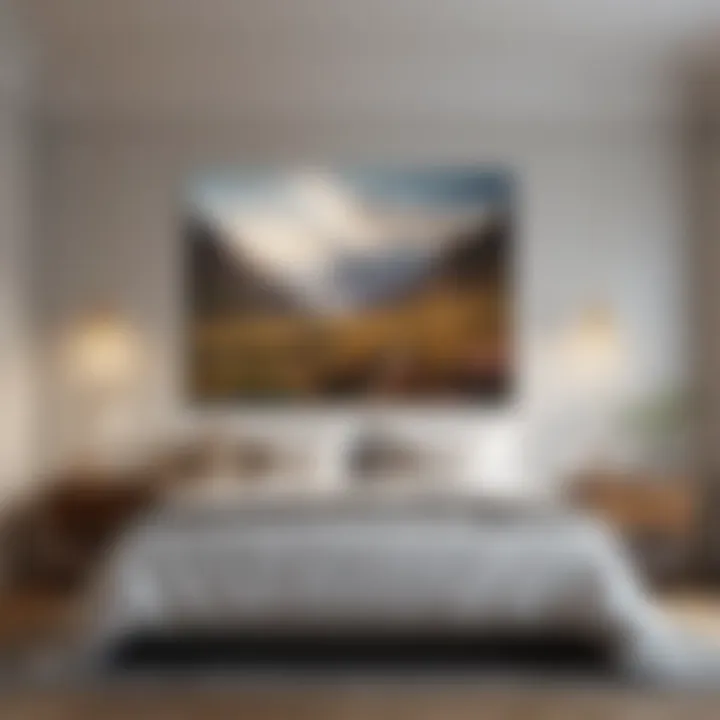
Themes and Subjects: Aligning with Personal Taste
When selecting a large picture, the theme and subject matter should reflect your personal taste and experiences. Your bedroom is a personal sanctuary, and the art you display can create emotional connections. Choose themes that resonate, whether it's serene landscapes, vivid abstracts, or tranquil nature scenes. Think about what makes you feel relaxed and happy. For example, if you have a love for the sea, coastal paintings might bring a soothing touch to your space. Ensuring that the subjects echo your stories and preferences can make your bedroom truly unique.
Color Schemes: Complementing Existing Decor
Color plays a vital role in how art interacts within your bedroom. The large picture should enhance the overall color palette rather than clash with it. Consider the dominant colors already present in your bedroom, such as wall color, furniture, and textiles. Choosing artwork that incorporates these colors can create harmony.
For instance, if your room features soft, pastel hues, a large artwork with similar tones can create a sense of cohesion. Conversely, a bold artwork can act as an accent piece, drawing attention effectively. Be mindful of both the colors in the artwork and how they relate to the existing elements in your space.
Art Styles: Exploring Various Aesthetics
Abstract Art
Abstract art gives you the freedom to interpret images in your own way. It can evoke thoughts and emotions without being tied to specific objects. The primary characteristic of abstract art is its focus on color and form, offering dynamic visual appeals. It is a popular choice because it can fit seamlessly into many styles of decor. The versatility of abstract pieces allows you to create a focal point without overpowering the rest of the room. However, its subjective nature means that not everyone may connect with this style, so choose wisely according to your taste.
Photography
Photography captures moments and landscapes, lending a personal touch to the decor. A large photograph can evoke nostalgia or spark joy, depending on the subject. The defining characteristic of photography is its realism, which adds depth to a room. It is beneficial as it often showcases real-life experiences or places you cherish. A downside may include the need for occasional updates as trends in photography evolve.
Landscape Paintings
Landscape paintings provide a serene escape through their representation of nature. One key characteristic is their ability to transport viewers to different environments, creating a peaceful ambiance. They are beneficial for bedrooms as they typically exude calmness and can be tied to favorite places. However, one disadvantage is that they may not align with modern decor styles if not carefully chosen.
Modern and Contemporary Styles
Modern and contemporary styles often reflect current trends, featuring clean lines and innovative concepts. A key characteristic is their ability to surprise and challenge traditional decor norms. Choosing modern art can reinvigorate a space. Its ever-evolving nature ensures there is always something fresh to explore. However, it may not appeal to everyone and might clash with more traditional furnishings.
Large pictures can significantly influence bedroom design. Their selection needs careful thought to create a comfortable and inviting environment.
Sizing and Proportion for Pictures
When you consider large pictures for bedroom walls, the sizing and proportion of artwork plays a crucial role. It affects not only how the art looks in the room but also contributes to the overall balance of the space. Art that is either too large or too small can disrupt visual harmony and influence the room’s ambiance.
Determining the right size can enhance not only the decor but the functionality of the room. A well-sized artwork can draw attention to specific areas and create the perfect focal point. The choice of an oversized canvas or a series of smaller images, for example, can set a different tone entirely. Thus, thoughtful consideration of the dimensions is essential for achieving a desired atmosphere that aligns with your personal taste and the room's design.
Determining the Appropriate Size
To determine the appropriate size of artwork, consider the wall space available. A common rule of thumb is to use two-thirds to three-quarters of the wall space if the art is the primary focus. For larger walls, a single statement piece can provide a sense of grandeur. If the space is more modest, multiple smaller pieces or a gallery wall may work better.
Key considerations include:
- Wall Dimensions: Measure the height and width of the wall.
- Visual Anchors: Account for furniture pieces that will sit below or beside the artwork.
- Room Scale: Think about the overall size of the room and how the piece will fit within it.
Ultimately, the goal is to make sure the artwork feels integrated into the space rather than awkwardly placed or overwhelming.
Balancing with Other Elements in the Room
Art must work in conjunction with the room's furniture and other decor. Balancing artwork with other elements is crucial to maintain a cohesive aesthetic. For instance, consider how the colors, patterns, and styles of your furnishings can complement or contrast with the chosen artwork.
When selecting large pictures, evaluate how they interact with surrounding elements such as:
- Furniture Heights: Ensure that your art is visible and does not compete with tall furniture, such as bookshelves or cabinets.
- Room Color Palette: Select pictures that either harmonize or provide a striking contrast to your existing color scheme.
- Light Sources: Natural and artificial lighting can change how art is perceived, influencing where you place it on the wall.
Achieving a good balance helps create a serene and inviting atmosphere in your bedroom.
Placement Strategies for Maximum Impact
When integrating large pictures into a bedroom's aesthetic, placement is fundamental. The way the artwork is positioned not only influences the visual appeal but also affects the overall atmosphere of the space. Effective placement strategies can transform a room, ensuring that the large picture serves its intended purpose, whether that is to evoke a certain mood, provide a focal point, or enhance the decor. Factors such as height, the layout of furniture, and proximity to other elements must be considered to maximize the artwork's impact.
Height and Line of Sight Considerations
The height at which a picture is hung is crucial in determining how it interacts with the space and the viewer. Generally, artwork is most effective when its center is at eye level, which for most people is around 57 to 60 inches from the floor. However, this can vary based on individual preferences and the specific room dynamics.
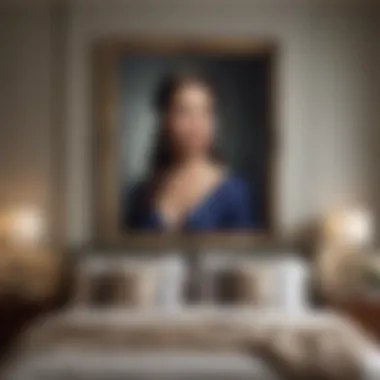
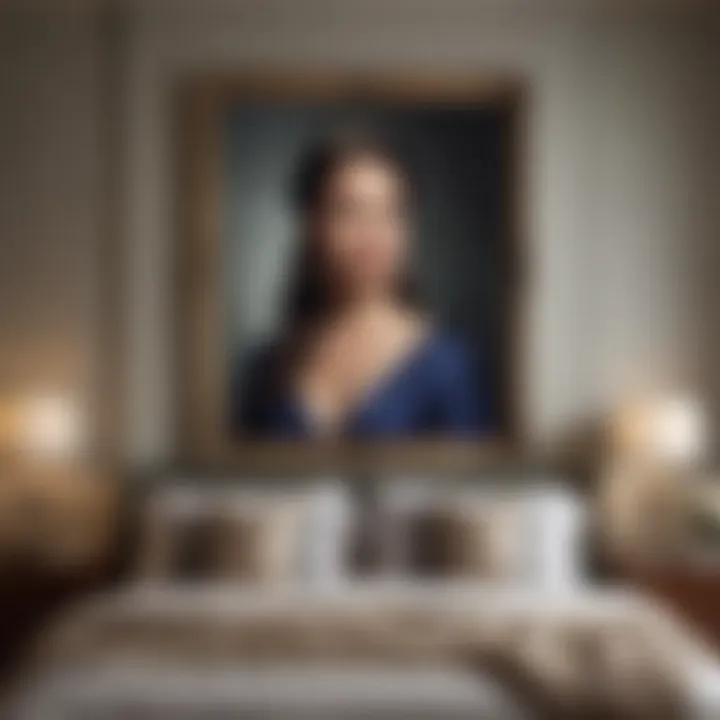
In bedrooms, if the bed has a headboard, it can be ideal to hang pictures about 6 to 12 inches above the headboard. This creates a unified look and makes the artwork more accessible visually. Additionally, one should consider how the artwork appears when someone is seated or lying on the bed. Avoid placing the artwork too high, as it risks becoming lost in the overall design.
"Art should be an essential part of the environment rather than a mere accessory."
Grouping Multiple Pieces for Effect
When one large picture is not sufficient, grouping multiple pieces can create a more dynamic visual experience. This technique can add layers, texture, and complexity to the wall space. A well-thought-out arrangement allows for these pieces to complement each other while also resonating with the room’s overall theme.
Grouping can take various forms, such as:
- Symmetrical Arrangements: These promote balance. Placing identical sizes of artwork in a grid offers a structured look.
- Asymmetrical Arrangements: This approach provides a more casual feel. Here, the viewer is led through the display by varying sizes and orientations.
- Thematic Grouping: Selecting pieces that share a common theme or color palette can create a story or a cohesive emotional experience.
Creating Focal Points with Artwork
In any room, a focal point can draw attention and ground the space. Large pictures can serve this role effectively, especially when they capture interesting themes or colors. A strategically placed picture can guide the eye and provide a natural flow within the design.
When establishing a focal point, consider the following:
- Contrast: The artwork should be distinct from its background and surrounding objects. This might mean choosing a vibrant piece against a neutral wall.
- Scale: The size of the picture matters. Large images often work best in spacious areas, but a smaller piece may work if surrounded by bolder decor.
- Lighting: Good lighting can elevate the impact of the artwork. Use wall washers, picture lights, or natural light to enhance color and detail.
Employing these strategies can significantly amplify the aesthetic potential of large pictures in bedrooms, transforming them into not just decoration but also impactful statements in the home.
Framing and Display Options
Framing and display options are vital elements when it come to showcasing large pictures in a bedroom. The right frame can enhance the overall aesthetic of the artwork and contribute to the room's ambiance. This section discusses the importance of selecting an appropriate frame style and the distinct display methods available, which can significantly affect how each piece interacts with the surrounding environment.
Choosing the Right Frame Styles
Selecting the right frame style is not merely an aesthetic decision; it also plays a role in protecting the artwork. Different materials and styles can communicate different messages.
- Wooden Frames: These are classic and can add warmth to a room. They work well with traditional or rustic decor.
- Metal Frames: Offering a sleek and modern look, metal frames suit contemporary interiors.
- Gallery Styles: A floating frame, where artwork is suspended between two glass panes, promotes a minimalistic aesthetic. This style makes the picture appear as if it is part of the wall itself.
- Contrast Framing: Selecting a frame color that contrasts the artwork can create emphasis and draw attention, which could be particularly effective in large pictures.
Consideration of Size is also important. Larger frames can overpower small artwork, whereas small frames can look insignificant against sizable images.
Unframed Presentations: Pros and Cons
Displaying artwork without a frame can give a gallery-like feel, especially in a bedroom setting. Nonetheless, it is essential to weigh the pros and cons.
Pros:
- Cost-Effective: Foregoing a frame can reduce costs, allowing you to invest in higher-quality art.
- Clean Look: Unframed images tend to create a more modern, uncluttered appearance, which is appealing to many homeowners.
- Flexibility in Placement: Since no frame is required, it can be easier to reposition or group pieces together without concern for aesthetic conformity.
Cons:
- Lack of Protection: Without a frame, the artwork is more susceptible to dust, moisture, and potential physical damage.
- Aesthetic Inconsistency: Depending on the room's decor, unframed pieces might disrupt the design balance.
- Difficult Installation: Unframed art may require extra considerations for hanging methods, such as adhesive strips or clips.
In summary, both framed and unframed options have distinct advantages and challenges. The choice largely depends on the mood you wish to create and the existing decor of the bedroom. Understanding these intricacies can aid in making an informed decision that complements your personal taste.
Maintenance and Care for Artwork
Taking care of artwork in your bedroom goes beyond mere aesthetics; it is essential for preserving the lifespan and integrity of the pieces. Even large pictures, which can dramatically enhance your space, require maintenance to ensure they remain vibrant and unscathed. This section will outline the significance of proper maintenance and care for artwork, detailing specific practices that will help keep your art in excellent condition.
Cleaning and Preservation Tips
Regular cleaning of artwork is crucial to prevent dust accumulation and fading. Depending on the medium, the approaches may vary. Here are some tips for keeping your art pristine:
- Use a Soft Cloth: For paintings and prints, a soft, lint-free cloth works best. Gently wipe the surface to remove dust without damaging the finish.
- Avoid Direct Sunlight: Sunlight can fade colors over time. Position pictures in areas where they are less exposed to direct light, or use UV-filtering glass in frames to protect them.
- Control Humidity and Temperature: Extreme fluctuations in temperature and humidity can cause warping or mold. Keeping a stable indoor climate is essential for the longevity of your art.
- Periodic Professional Cleaning: Consider hiring a professional art conservator for valuable pieces. They will use specialized methods that ensure comprehensive cleaning without damage.
These tips contribute to an aesthetic that feels fresh and cared for, reinforcing the room's atmosphere.
Avoiding Common Damage Issues
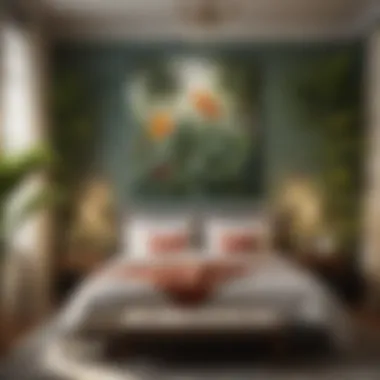
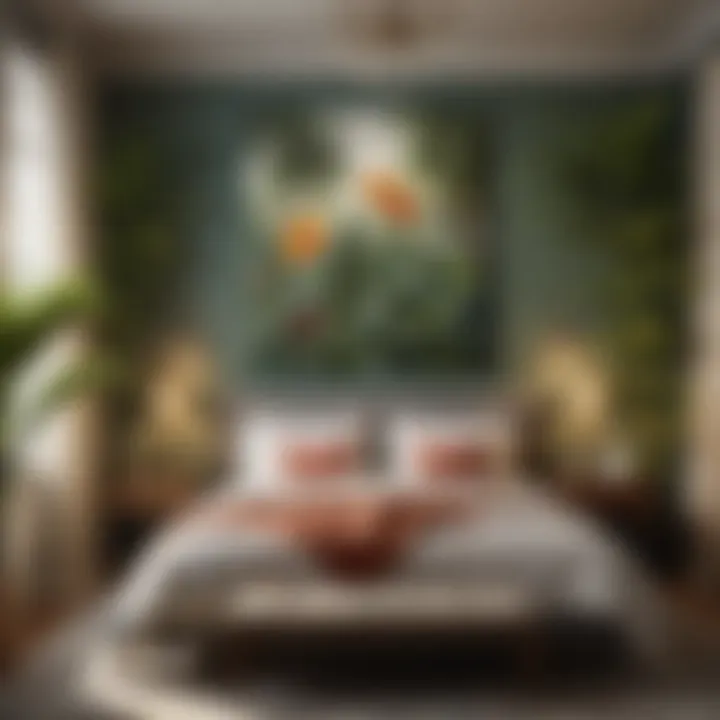
While maintaining artwork is important, it is equally vital to understand how to avoid common issues that may arise. Here are some precautions to take:
- Keep Away from Water Sources: Install artwork away from bathrooms or kitchens where moisture may cause damage. Water can warp paper and damage the colors.
- Secure Against Fall Risks: Ensure that large pictures are hung securely on the wall to avoid falls, particularly in homes with children or pets.
- Monitor Insects and Pests: Insects like moths can damage paper art. Regularly check for indications of such issues and take necessary actions to protect your investment.
- Avoid Heavy Cleaning Products: Do not use abrasive cleaners on frames or surfaces. Stick to gentle cleaning solutions specially designed for artwork.
"Proper care not only maintains the beauty of your art but also protects your investment over time."
Recognizing and addressing these considerations can help you preserve the beauty and significance of your large artwork for years to come. In doing so, you ensure that your bedroom remains a sanctuary of personal expression and beauty.
Incorporating Technology in Art Display
In an era where technology intertwines with daily life, it is essential to consider how it can enhance art presentation in bedrooms. Integrating technology in art display is more than just an aesthetic choice; it offers significant utility, flexibility, and even a level of interactivity that traditional artwork cannot provide. Today’s large pictures can be augmented with innovative tech solutions that allow homeowners to personalize their environments effortlessly. This section will explore two primary technological advancements: digital art frames and projection systems.
Digital Art Frames and Their Benefits
Digital art frames have emerged as an attractive option for displaying artwork. Unlike conventional frames that showcase a single piece, digital frames can exhibit a rotation of images. This feature allows for continuous refreshment of the visual appeal in the bedroom, as one can display various themes or moods at different times. For instance, a homeowner could display calming landscapes during the day and vibrant abstract art at night.
Moreover, many digital art frames come with Wi-Fi connectivity, enabling users to upload images from their devices, social media, or even streaming platforms. This capability expands the selection of artwork significantly without needing to buy physical pieces. Purchasing a digital frame translates into opens up opportunities to invest in art from emerging artists or even local photographers, fostering creativity in the space.
Benefits of digital art frames include:
- Flexibility in content showcasing.
- Ability to update images without additional costs.
- The option to curate artwork based on current decor or seasons.
- Often includes a built-in calendar function, displaying your art and telling the time.
Given these features, one can view a digital art frame not merely as a piece of technology but a dynamic tool for personal expression.
Using Projectors for Dynamic Displays
Projectors present an even more versatile option for incorporating art into bedroom design. Unlike static images, projectors allow for a more immersive experience by displaying artwork in large formats across a wall. This technique can be ideal for themed settings, such as movie nights or holiday celebrations where visuals can dramatically enhance the atmosphere.
Projectors also enable dynamic displays. Homeowners can host multimedia evenings or exhibitions, showcasing not only static artwork but also videos and animations to create a lively environment. One might think of arranging a tranquil beach scene one moment and then transitioning into a starry night sky the next, all with a simple remote control.
Important considerations with projectors include:
- Space and placement: Proper positioning is crucial for optimal viewing.
- Light conditions: Projectors perform best in darker rooms; managing light can enhance the image quality.
- Resolution and quality: Selecting a projector that provides crisp images ensures artwork is displayed at its best.
The integration of projectors adds a layer of sophisticated creativity. As homeowners become more daring in their choices, projectors can offer a level of engagement that traditional art simply cannot match.
The incorporation of technology transforms how art is experienced, allowing for personalization and fluidity in bedroom design.
In summary, both digital art frames and projectors are leading a new wave in the context of bedroom aesthetics. Their innovative characteristics provide options that align with contemporary lifestyles—one can embrace art that evolves, changes, and captivates. Utilizing technology enhances not only the visual appeal but also fosters a deeper connection to the art that fills the personal space.
Budget Considerations for Artwork
When it comes to enhancing a bedroom's aesthetics through large pictures, budget considerations are crucial. The financial aspect influences not only the selection of artwork but also the potential for creating a desired atmosphere. Many individuals overlook the importance of budgeting, leading to hasty decisions that do not align with their vision or style. Therefore, discussing budget strategies is essential in this guide.
Investing in Quality vs. Affordability
Investing in quality artwork often yields a more satisfying outcome than focusing solely on affordability. High-quality art pieces may come with a higher price tag, yet they tend to offer durability and a timeless appeal. Quality artwork can become a conversation starter and a statement piece in a room.
However, affordability is also significant. Many people live on fixed incomes or have specific budget constraints. This does not mean that one must settle for inferior art. It’s essential to find a balance. Buying from local artists or galleries can provide quality pieces at reasonable prices. Moreover, consider purchasing prints or reproductions of more expensive originals.
A few important points to consider:
- Value Retention: Quality art pieces can appreciate over time, becoming investments.
- Emotional Connection: Spending more might lead to acquiring art that resonates deeply.
Ultimately, one must weigh the emotional and financial investment in art. Allocating a more considerable part of a budget for one meaningful piece might outweigh the satisfaction derived from multiple affordable prints.
Exploring Alternative Art Sources
Broadening the search for artwork can open various doors, allowing for unique options that fit various budgets. Purchasing from alternative sources can provide significant cost savings without sacrificing quality.
Some avenues to explore include:
- Local Art Shows: They often feature emerging artists selling their work at lower prices.
- Thrift Stores and Flea Markets: These places sometimes house gem pieces waiting to be discovered.
- Online Marketplaces: Websites like Etsy or eBay often feature original artwork and prints at competitive rates.
- Community Art Programs: Participating in or visiting local community showcases can yield affordable options.
As a reminder, always verify the authenticity of pieces purchased from less conventional sources. This can help you ensure the value of your investment.
Exploring a variety of art sources and weighing investment quality can lead to personal satisfaction and a beautiful bedroom.
In summary, budget considerations are integral in deciding on large pictures for bedroom walls. Striking the right balance between quality and affordability, alongside exploring alternative art sources, will enhance both the look and feel of your space. By approaching your art purchases with a well-defined budget, you can create a sanctuary that reflects your personal taste and style.















